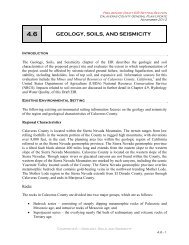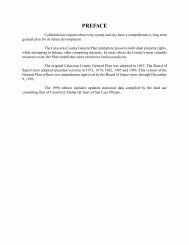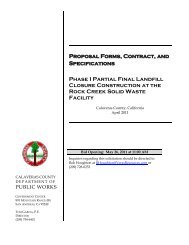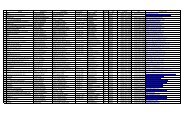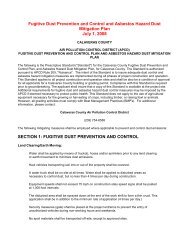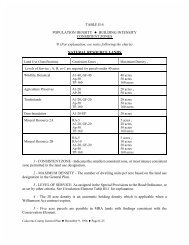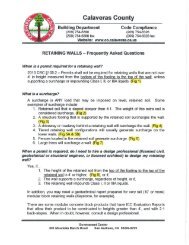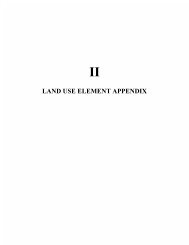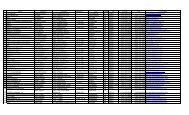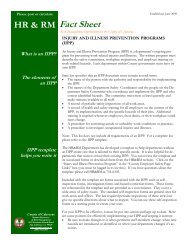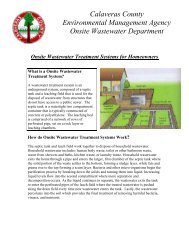Conservation Element - Calaveras County Government Services
Conservation Element - Calaveras County Government Services
Conservation Element - Calaveras County Government Services
Create successful ePaper yourself
Turn your PDF publications into a flip-book with our unique Google optimized e-Paper software.
Goal IV-4:Maintain and increase timber land productivity.Policy IV-4A: Encourage sustained yield timber production and harvest.5.0 Mineral ResourcesImplementation Measure IV-4A-1: Utilize applicable provisions of the ForestImprovement Act of 1978 (Public Resources Code section 4790 et seq.).Areas receiving the Mineral Resource Lands designation have naturally occurring depositsof chemical elements or compounds formed from inorganic processes and organic substances.Mineral lands include both surface and subsurface deposits.5.1 Mining HistoryThe Gold Rush of the mid-1800's provided the major attraction to <strong>Calaveras</strong> <strong>County</strong> andthe rest of the Mother Lode. Since that time, mining has been a major component of the <strong>County</strong>'seconomy and livelihood. Between 1880 and 1962, the recorded value of minerals produced in<strong>Calaveras</strong> <strong>County</strong> amounted to over $200 million. Of that total, gold, limestone and copperaccounted for the greatest amount. Although production figures are not available for the largequantities of gold that were mined before 1880, it is documented that the largest single piece ofgold ever found in the Western Hemisphere -- weighing close to 150 pounds -- was unearthed atCarson Hill on November 22, 1854. Other minerals extracted in quantity in the past include quartzcrystal, copper, zinc, silver, lead, chromite, clay, sand, gravel and stone. At least 26 minerals havebeen produced commercially within the <strong>County</strong>. In more recent years, limestone, asbestos, sandand gravel, industrial minerals, and gold have accounted for most of the <strong>County</strong>'s mining industry.Even with increases in recycling of mineral products, a large demand remains for newlymined materials. New mineral discoveries are being made; however, development of new minesis a long process, often requiring several years and substantial investment before operation begins.5.2 Mining OperationsThe California Department of <strong>Conservation</strong> Division of Mines and Geology (DMG)maintains a database of mines and mining activity throughout the state. This source identifies 77mines in <strong>Calaveras</strong> <strong>County</strong>; however, more than half are presently classified as idle. The locationof these mines is shown in Mine Location map, Page IV-12. A detailed description of the productsand a list of the name, operating company, the main products and operational status of each mineis contained in the <strong>Conservation</strong> <strong>Element</strong> Appendix.5.3 Potential Mineral ResourcesThe history of mineral production and recent surveys suggest that much of <strong>Calaveras</strong><strong>County</strong> has the potential for further mineral resource development. As mining technology andprocesses improve over time, sites that were economically infeasible in the past may again becomelucrative. Mineral Resource map, Page IV-13 shows potential mineral resources areas in thecounty.<strong>Calaveras</strong> <strong>County</strong> General Plan z December 9, 1996 z Page IV-11



